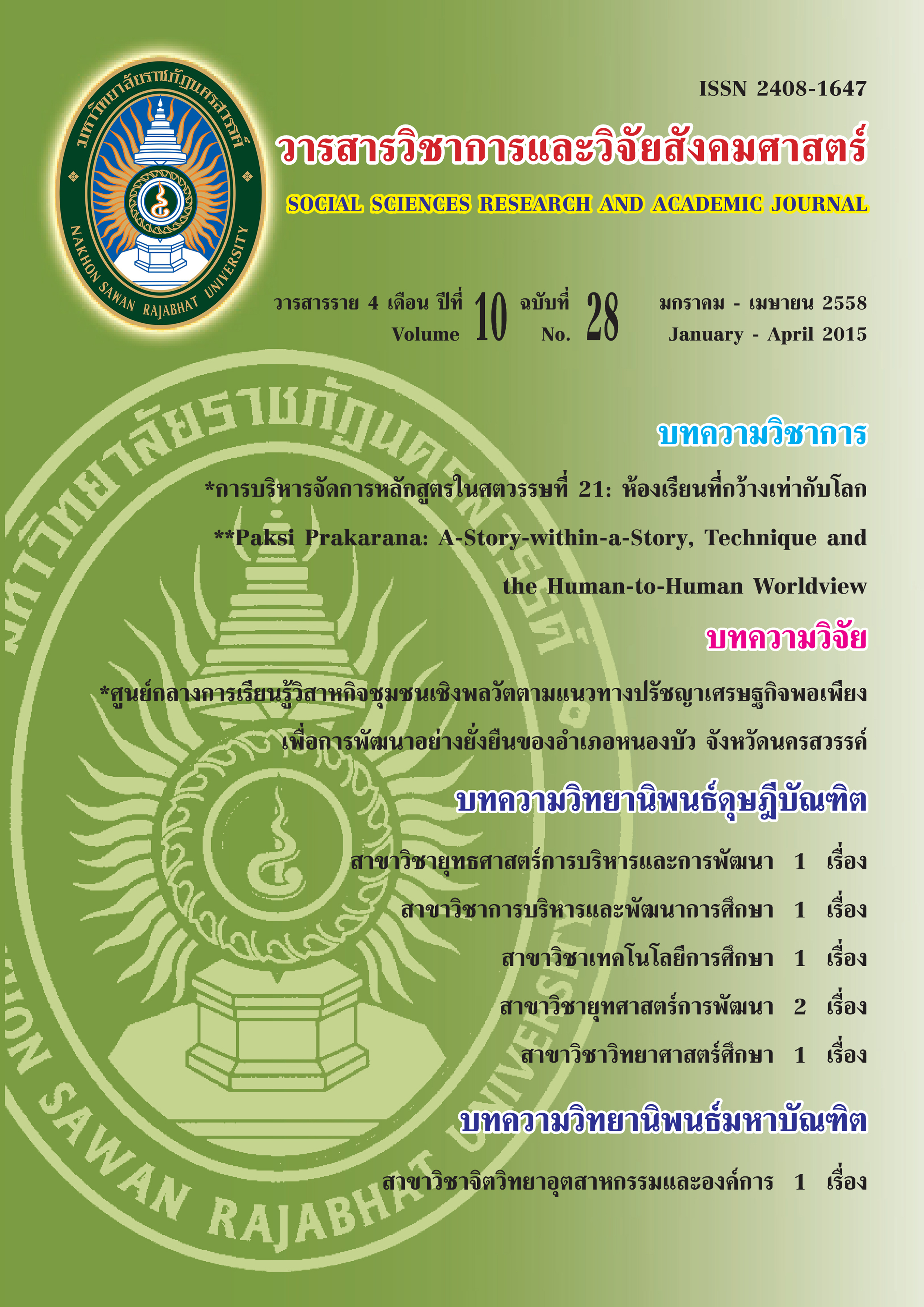รูปแบบยุทธศาสตร์การพัฒนาคุณภาพงานป้องกันและควบคุมการติดเชื้อ ในโรงพยาบาลชัยนาทนเรนทร; Stratigic Model of Quality Development on Nosocomial Infection Prevention and Control at Jainad Narendra Hospital
Main Article Content
Abstract
บทคัดย่อ
การวิจัยนี้มีวัตถุประสงค์ 1) ศึกษาคุณภาพงานป้องกันและควบคุมการติดเชื้อในโรงพยาบาลชัยนาทนเรนทร 2) สร้างรูปแบบยุทธศาสตร์การพัฒนาคุณภาพงานป้องกันและควบคุมการติดเชื้อในโรงพยาบาลชัยนาทนเรนทร 3) ทดลองใช้รูปแบบที่สร้างขึ้นในกิจกรรมที่สำคัญ 3 กิจกรรม ในการศึกษาครั้งนี้ใช้เกณฑ์การพัฒนาคุณภาพบริหารจัดการภาครัฐ (PMQA) วิเคราะห์ผลการดำเนินงานของงานป้องกันและควบคุมการติดเชื้อในโรงพยาบาล และในหอผู้ป่วย/หน่วยงาน จำนวน 33 หน่วยงาน และทดสอบกับบุคลากรในโรงพยาบาลชัยนาทนเรนทร โดยเลือกประชากรเป็นกลุ่มตัวอย่างแบบเจาะจง ในแต่ละกิจกรรม
ผลการวิจัยนี้พบว่า
1. คุณภาพงานป้องกันและควบคุมการติดเชื้อในโรงพยาบาลชัยนาทนเรนทรได้ค่าเฉลี่ย 2.8
2. รูปแบบยุทธศาสตร์การพัฒนาคุณภาพงานป้องกันและควบคุมการติดเชื้อในโรงพยาบาลชัยนาทนเรนทร
3. ผลการทดลองใช้รูปแบบในกิจกรรมที่สำคัญ 3 กิจกรรม มีดังนี้
3.1 การทดสอบประสิทธิภาพการล้างมือโดยใช้สารเรืองแสง และพฤติกรรมการล้างมือของบุคลากร จำนวน 656 คน พบว่า 1) ด้านประสิทธิภาพการล้างมือผ่านเกณฑ์ 46.18% 2) ด้านมีความรู้ตาม 5 Moment มีความรู้ 73% 3) ด้านทักษะการล้างมือ 7 ขั้นตอน อยู่ระดับดี 47% พอใช้ 27% และปฏิบัติไม่ถูกต้อง 26% ตามลำดับ 4) ล้างมือด้วยน้ำสบู่เฉลี่ยวันละ 16.77 ครั้ง/วัน และใช้ Alcohol hand rubs เฉลี่ยวันละ 8.07 ครั้ง/วัน
3.2 ผลการประเมินผู้ป่วยภาวะ SIR และการรักษาผู้ป่วย Sepsis ในแผนกอายุรกรรมหญิง จำนวนผู้ป่วย 331 ราย พบว่า 1) พบภาวะ Septic shock 48.64% Sepsis 40.00% และ Severe sepsis 11.36% ตามลำดับ 2) รับใหม่ 43.81% และรับ Refer 45.32% และ 3) ผู้ป่วยหายกลับบ้านได้ 66.76% และเสียชีวิต 23.87%
3.3 ผลการปฏิบัติของพยาบาลวิชาชีพ จำนวน 24 คน ในการดูแลผู้ป่วยใส่เครื่องช่วยหายใจในห้องผู้ป่วยหนัก พบว่าได้คะแนนในภาพรวมค่าระดับคะแนน 0.796 อยู่ในระดับดี แต่มีบางกิจกรรมที่ต้องปรับปรุง และภาพรวมในปี 2557 อัตราการเกิด VAP = 5.17/1,000 วันเสี่ยง
Abstract
The purposes of this research were 1) to study the quality of prevention and control of nosocomial infection in Jainad Narendra Hospital, 2) to build up the strategy quality development of nosocomial infection prevention and control models in Jainad Narendra Hospital, and 3) to experiment on the models created in three activities. This research used Public Sector Management Quality Award (PMQA) to analyze performances of 33 sections under nosocomial infection prevention and control division and patient departments and to experiment with the personnel of the hospital. The samples in each activity were selected with the purposive sampling method.
Research results:
1. The mean of work quality in nosocomial infection prevention and control was 2.8.
2. There was the strategy of quality development on nosocomial infection prevention and control in Jainad Narendra Hospital.
3. The results of the experiment in these three activities were as follows:
3.1 The hand washing efficiency test using a fluorescent substance and hand washing behavior test in 656 personnel showed that: a) 46.18% of samples passed the standard of hand washing efficiency. b) 73% has knowledge of 5 Moments of Hand Hygiene. c) 47% has a good skill of 7-step hand washing, 27% faitly followed the seven steps and 26% did not wash their hands correctly.
3.2 The assessment of patients with SIR and treatment of patients with Sepsis at the female medical department with 331 patients showed that: a) The Septic shock were found most often at 48.64%, whereas Sepsis was at 40.00% and Severe Sepsis was at 11.36%. b) 43.81% of the patients were new patients and 45.32% were referred cases. c) 66.76% of them recovered and could get back home and 23.87% of them were dead.
3.3 The performance of twenty-four nurse who take care of patients with the respirator in ICU was at a good level of 0.796. However, there were same activities which needed to be adjusted, Overall, the rate of ventilator associated pneumonia (VAP) in 2012 was 5.17/1,000 days on respirator.


